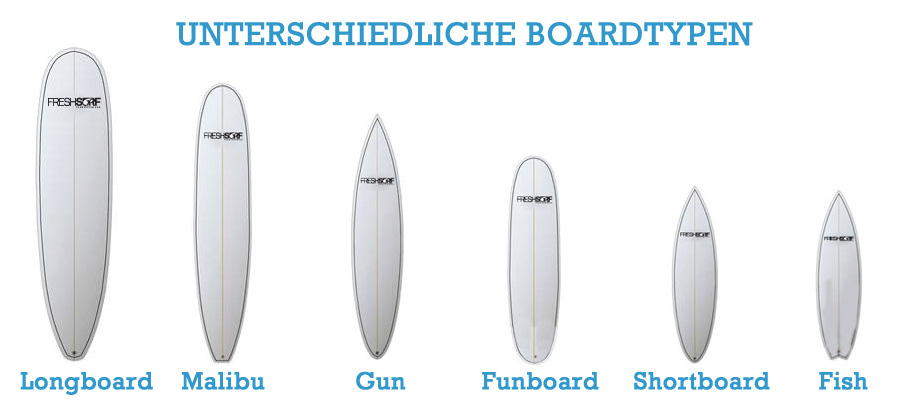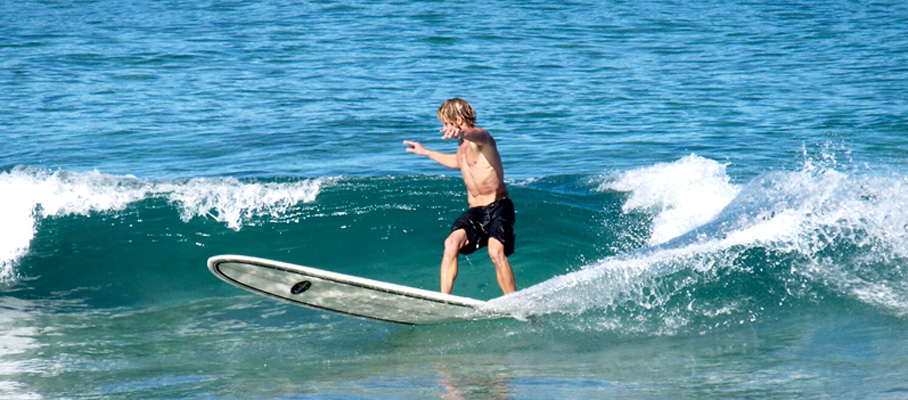Theory of surfing – in our surf school and camp on Fuerteventura
Different sizes, shapes and hints on the right surfboard for your abilities!
Finding the best surf board matching your abilities depends on various criteria:
Choosing the right surfboard depends on a number of factors e.g. the type of wave and attributes of the surfer like height, weight, physical condition, experience and motivation.
The most common mistake is choosing a surfboard with too little flotation. Many people want to surf on the same board as pro-surfers; however this will do you no favours. If the flotation is not sufficient, because the surfboard is too small or narrow for you, it will be a lot harder to catch waves, to surf on them and to have fun in general. It would be wise to start off on a bigger board, offering the best support when learning, before slowly making your way down to a short board.
To ensure you end up with the right surfboard, here is a brief introduction to the different board shapes and types. Every purchase involves a compromise; you have to be aware that there will be no perfect surfboard which will suit you and all wave condition at all times.
 In general board types vary in
In general board types vary in
- Flotation, which will effect whether you catch the waves or not
- Stability, e.g. during paddling for the waves
- Speed, e.g. during paddling for the waves
- Manoeuvrability
Long board (Malibu), Mini-Malibu, Fun board, Short board as well as Fish and Semi-Gun & Gun with possible crossovers between the shapes.
How do we measure a surfboard?
Worldwide the measurements of surfboards are quoted in feet and inches. A board described as 6´4“ × 18 ⅔“ × 2 ⅜“ is 6 feet, 4 inches long, 18 ⅔ inches wide and 2 ⅜ inches thick.
The thicker the board, the more flotation you will have. So heavier surfers and beginners need thicker boards.
Further differences between board types are seen in the tail, stringer and the number of fins etc, as well as in the general design and material of the surfboard.
We will now look at each of the following types of board in the following sections:
- Long board (Malibu)
- Mini-Malibu
- Fun board (Evolution, Hybrid Egg)
- Short board
- Fish (Retro und New-School)
Longboard
- Surf spots with small and weak waves
- Surfing in an elegant and relaxing style
- Surfing in slowly breaking waves
You will have to pay around 800-1200€ for a good long board; however there is no price limit.
Mini-Malibu
- Surfing small to average sized waves
- Beginners to intermediates wanting to enjoy their own surf experience
- Experienced surfers wanting to have fun even in smaller waves
Fish (Retro und New School)
The fish is a board which is more suitable for smaller waves and measures between 5´5“-6´4“length. It has little rocker and much more volume than the classic short board. The swallow-tail is quite flexible and fast & also handles steep waves. The fish can also be used in slightly bigger waves by increasing the size of the fins. It would be a good choice for anyone looking to improve, but who is not yet ready for a short board.
Retro Fish
Retro Fish boards are extremely short, but quite wide and thick, with a round nose and a wide fish-tail. They make it possible to catch waves easily due to the high volume in comparison with a short board. Radical turns on the wave as well as calmly surfing down-the-line will be no problem. Retro Fish boards are not suitable for beginners! (Due to the small size of just 6’2”max). Retro Fish boards are not easy to paddle or easy to use during take-off. Because of the flat rocker line, there is a danger that the nose will dip into the water during take-off.
New-School-Fish oder Performance Fish
This board type has more rocker, is thinner and longer. One could say that it is a short board which is simply a bit wider and thicker with a fish-tail. For this reason, beginners, as well as surfers who have surfed a Malibu previously, should not use this type of board, with the exception of a long fish board which measures app. > 6’7”. For experienced short board surfers, we recommend short fish boards in smaller and less powerful waves.
Funboard, Evolution, Hybrid
- Intermediate surfers who wish to surf on a transportable board
- Intermediate surfers who wish to catch waves without a lot of paddling & who wish to enjoy themselves in small waves as well
- Tall and heavy surfers
The fun board is for surfers who have little time to go surfing and who want to make the most of it! The fun factor has priority in this case rather than the aim to surf on a short board one day!
Egg
Shortboard
It is a long learning curve before beginners finally become able to surf on a short board. We recommend slowly making the way down from a Malibu or a Fun board to a Fish-Shape board and then a short board. There is no other surf board type with so many variations than the short board.
A typical short board measures between 5´8“– 6´8“in length and carries a square, round or swallow tail. Short boards are designed for making radical and fast turns rather than slowly surfing down waves like you would do with a long board. Most people are fascinated by short boards and they are probably the only boards they know about when asked. The development of the short board has been influenced by skateboards, which also explains the design and the perceived element of ‘attack’. They have a sharp arched nose in order to adapt to the form of the wave. More manoeuvrability and different variations of the tail and the bottom are also attributes of the short boards, besides easy transportation. Short boards are also lighter, with less volume than other boards. These characteristics require you to constantly move and change position when surfing. This is why short boards are not boards beginners, as they demand a lot of experience and fitness. Before changing from a Malibu to a short board, you should consider trying other shapes (e.g. a fun board) first.
Duck diving is a technique by which surfers dive under the surface of waves to avoid being smashed back to the shore when a wave over app. 2ft. approaches. This manoeuvre became possible with the help of a short board. Surfers generally own more than one short board, each carrying different attributes which can be helpful in different wave types. To surf on a short board not only requires a certain amount of experience and knowledge but furthermore fitness, enough time to practice and a good amount of the right motivation & self confidence.
To buy a new short board in Europe will cost around 400-600€. But depending on the material it can also cost a lot more. Purchasing a short board in places like Australia or South Africa can be slightly cheaper (around 300€ depending upon the exchange rate).












